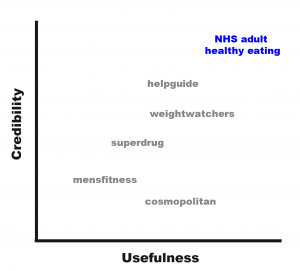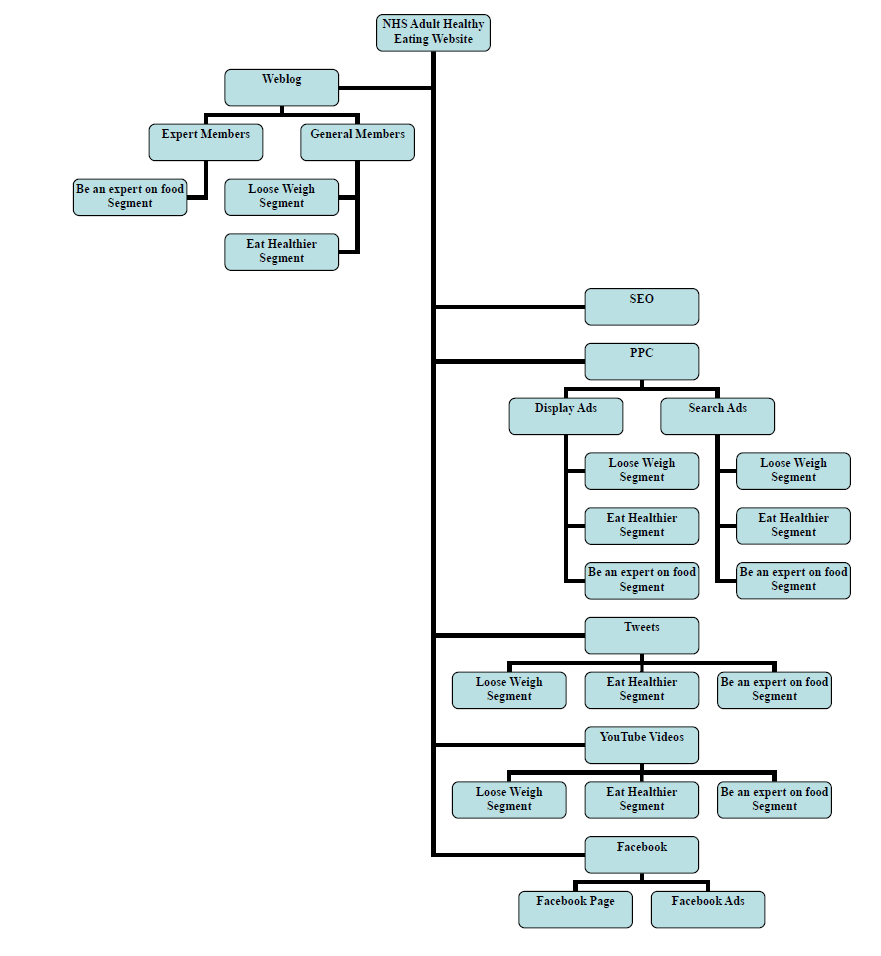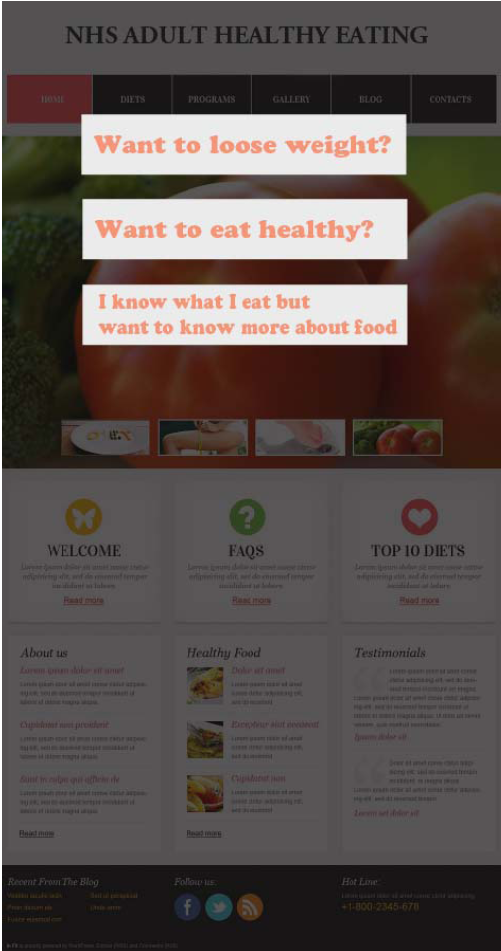The new adult healthy eating campaign is a requirement for Public Health England as part of its response to the demands of the UK Government, and UK society as a whole, to address the issues of obesity and healthy eating in this country. NHS Choices runs a healthy eating campaign but in its current form this cannot be accurately assessed for effectiveness. A new, community-based adult healthy eating website, supported by social media, is needed to address this issue . The community will consist of individuals wanting to change their eating habits, and industry experts wanting to share their knowledge about healthy eating. The new website will be segmented according to the motives of the community members who join the campaign. The ready-segmented population of users will be targeted with messages relevant to their healthy eating issue using PPC, Twitter and video messages. Regular surveys will be sent to registered users to ongoingly verify the effectiveness of this much-needed campaign.
1. Situation analysis
1.1 Campaign digital platforms
a. The Health and Social Care Centre runs a healthy eating campaign on their websites:
- NHS Choices http://www.nhs.uk/livewell/healthy-eating/Pages/Healthyeating.aspx
- Change4Life (also available from www.nhs.uk but not designed for adults)
b. The healthy eating campaign is supported by social media on:
- NHS Choices on Facebook
- NHS Choices on Twitter
- NHS Choices on G+
- Change4Life on Facebook
- Change4life on Twitter
1.2 Basic analytics www.nhs.uk
a. General information about traffic to NHS Choices website:
- 4,5 m of pages indexed by Google
- 1.9 m external inbound links
- There were 11,326,111 page views last week
- of which 3,7 m page views were from mobiles and 9 m from iOS and Android devices
b. The most popular sections of the NHS Choices website:
- Treatments and conditions 56%
- Live Well 10% (space for improvement)
- Service directories 7%
1.3 User characteristics
NHS Choices is visited mostly by female users (59%). Men increasingly visit NHS Choices after turning 35 and 65 years of age. Eighty-seven percent of all social media references to NHS Choices is in some respect positive, and 13% negative. People discuss NHS Choices mainly on Twitter (80%) but also on Facebook (12%), on weblogs and forums, often referring to celebrity tweets (such as those of Stephen Fry) for relevant information. Tweets and weblogs of third party opinion leaders are also generating traffic to NHS Choices.
1.4 Market forces
The UK population is becoming increasingly health conscious. Mass media in the UK frequently runs healthy eating and lifestyle campaigns, making people more aware of what kind of diet is good – or bad – for them. There is pressure from both the UK government and society at large for Public Health England to build a lasting legacy across a number of key commitments: namely healthy living and reduction in the numbers of overweight and obese people:
“Tackling obesity is fundamentally an issue about healthy and sustainable living for current and future generations. This is only likely to be achieved if there is a paradigm shift in thinking, not just by Government but by individuals, families, business and society as a whole.” UK Government (2013)
UK lawmakers are under increasing pressure from the government to look at ways of how to regulate the activities of food manufacturers, particularly those producing foods rich in fat and sugar (BBC, 2013). The fact of the London 2012 Olympics is used ongoingly by major political parties to lobby the UK Government into prolonging its legacy, and use it as an incentive for change in lifestyle and eating habits towards new and healthier ones. “By the end of the decade Britain is amongst the most physically active countries in the developed world” (UK Government, 2014).
Technology allows for more accurate assessment of the effects of an unhealthy diet on the human body. Data from scientific research is used to provide physical evidence for the negative effects of an unhealthy diet, and to promote healthier living (BBC, 2014). An example of this was seen on the BBC ‘Horizon’ series dedicated to the effects of sugar and fat-rich foods on people’s health. Certain technologies, in the form of mobile applications for example, can be used to help people to monitor their daily intake of calories.
1.5 SWOT
a. Strengths
NHS Choices receives traffic of over 37 million visits per month, and as an extension of the NHS brand enjoys high credibility among UK Internet users as a source of healthy living advice. The website is a well-searched engine optimised for branded keywords and two to three word key phrases relevant to healthy eating.
b. Weaknesses
www.nhs.uk is not responsive to different screen sizes. This has a major bearing on user experience, and limits the usefulness of the website on mobile devices. The font size on www.nhs.uk might not be suitable for users with vision problems. NHS Choices and its campaigns lose traffic and influence as an opinion leader, to the celebrity-backed commercial brands engaging in ‘pay per click’ (PPC) advertising. NHS-hosted videos cannot easily be shared on social media. Unlike e-tailing websites, the point of conversion cannot be easily defined for the new adult healthy eating campaign.
c. Opportunities
www.nhs.uk is a well-searched engine optimised (SEO) for relevancy to the new adult healthy eating campaign, with keywords such as ‘healthy living’ and ‘healthy diet’. The new adult healthy eating campaign will benefit from the current SEO position of www.nhs.uk if made available online as its subdirectory.
The new adult healthy living campaign would be more effective in engaging users if the point of entry to online conversation about healthy eating is defined as a conversion. The use of PPC advertising could boost awareness about the campaign and its effectiveness. Given conversion and touchpoints clearly defined, it would be possible to engage the campaign in attribution modelling, and optimise the return on investment (ROI).
Existing technologies such as Spider Linker™, can find billions of new ultra long tail keywords, and create new, more relevant content pages for the new adult healthy eating campaign which previously didn’t exist – thus maximising its voice online as the principal UK source of healthy eating information.
The syndication services for the new adult healthy eating campaign could be simplified by an innovative service offered by https://import.io/ capable of transforming any website into a table of data, or a structured API efficiently, without writing any code (Import.io, 2014). This solution could be used to help personal trainers, dieticians and bloggers who publish information about healthy eating, promoting the new adult healthy eating campaign on their weblogs and websites.
Most popular keywords typed by users into search engines when searching for information about healthy eating could be used for service segmentation. Twitter campaigns could be segmented according to the type of problem, for more accurate user-targeting. Facebook and Google+ campaigns for adult healthy eating could enhance effectiveness by including physical evidence in the form of videos demonstrating the success and failure stories of those who attempted to change their eating habits.
d. Threats
A marketing campaign that is deeply reliant on SEO in Google may be risky and unpredictable, as any change in the Google algorithm may negatively affect incoming traffic to the website. The managers of the new adult healthy living campaign should diversify the channels of digital engagement for their new campaign, to spread the risk across a variety of platforms. The hardware used for hosting the new NHS Choices campaign (server) should be highly scalable and capable of withstanding high fluctuations in the volume of traffic to the website. The NHS campaign managers should prepare their organisation for the possibility of a lawsuit by users and commercial companies who may challenge the truthfulness of the information published in the new adult healthy eating campaign. In order to mitigate risk in any dispute, speedy access to records and proof of authenticity will be a necessity. Services offering snapshots of a website at regular intervals, and designed for this purpose, are available from specialist service providers.
1.6 Competitors
Charities and commercial companies who publish materials about adult healthy eating, especially those utilising PPC and affiliated marketing programmes:
- http://www.weightwatchers.co.uk/
- http://www.cosmopolitan.com
- http://www.mensfitness.co.uk/
- http://www.superdrug.com/
- http://www.helpguide.org/
2 Where do we want to be?
The new adult healthy eating campaign seeks to share and to spread knowledge, bringing people together to solve problems related to the issue of healthy eating. However, in order to build an evolving ecosystem in this respect, and one which benefits the UK public, the new adult healthy eating campaign must first focus on attracting a critical mass of content to make the campaign sufficiently appealing and useful to the public. To do this, it must address the needs of the scientific community, and the service providers that currently supply information in this field. The project must seek to create a community of users, including those of the scientific community, service providers involved in supplying the information, and consumers.
In the short run, the new adult healthy eating campaign must develop a new, mobile and user- experience optimised website, with architecture suitable for problem segmentation and community management. This new multi-channel campaign will be aiming to establish its position as an opinion-leading brand in the field of adult healthy eating. Right from the outset, the campaign will be collecting and analysing quantitative, as well as qualitative, data to allow the campaign managers to establish conversion points, and to define the ROI. The aim is to achieve a 25% conversion rate by 1st August 2015.
In the long run, the adult healthy eating campaign, carrying a decisive and authoritative voice, will set industry standards and positively change the eating habits of the UK population.
3 Strategy
The key elements of the digital strategy for the new adult healthy eating campaign involve the following: aligning the newly built channels and features of the new campaign with the existing structure of NHS Choices; analysis of the target market characteristics and their needs; and the plan to leverage the potential of existing infrastructure and experience with digital marketing drawn from other NHS Choices campaigns.
3.1 Targeting
The potential users of the new adult healthy eating campaign will have different demographic characteristics, needs and behaviours to children using Change4Life. It is therefore imperative to use different approaches to segmentation. Segments will be determined by the kind of problem those who participate in the campaign would like to resolve; those segments will then be selectively targeted with specific content and messaging published on the new website, and elsewhere on the web. As an example: one segment will be targeting community members wanting to change their eating habits to lose weight, and another segment will be targeted at those who seek new ways of eating healthily. Micro-targeting is one of the major benefits of digital marketing. (Appendix 1)
3.2 Positioning
The key selling proposition of the new adult healthy eating campaign for the public is the availability of free, valuable and credible information about healthy eating. For the scientific community, on the other hand, there is the attractive potential for sharing their expertise and contributing to this invaluable national campaign. In order to reinforce this proposition, and to create a brand based around this new platform, an association with industry experts is necessary. In order to reinforce the campaign’s credibility, materials backed by scientific research should be immediately apparent and accessible to the customer, on initial interaction with the online campaign.
3.3 Proposition and the marketing mix
Service will be offered on the basis of membership of the community of healthy eaters. The community members will be able to engage in conversation about healthy eating, and benefit from practical and science-backed advice on how to eat healthily. The advice will be categorised according to the level of engagement with the campaign, where the more engaged users (those signing up with their emails) will have access to materials not available to the less engaged users. Materials published on all campaign platforms (website, social media and weblog) will be in the form of graphic material such as videos, photographs and articles written by experts on the effects of healthy and unhealthy eating on the human body. There will also be mobile applications designed to help adults manage their healthy eating plan.
The services offered, and membership of the community, will be free of charge. The new www.nhs.uk hosted website will serve as the main platform for the campaign. The new website will be connected via Application Programming Interface (API) to social media platforms such as Twitter, Facebook and Google+ to allow members to not only join the community with one click, using their social media accounts, but to bring dynamic content to the new adult healthy eating website, and facilitate dialogue. The new adult healthy eating campaign will be primarily promoted on www.nhs.uk. The campaign will also be promoted by affiliate marketing schemes allowing animated banner placement on third party websites. Additionally, social media agency will be contracted to run targeted social campaigns on Facebook (please see paragraph 3.7 c for more details).
The CRM campaign will follow promptly, when an adequate number of users has signed up for membership. Services offered online will include an automated online assistant capable of helping visitors to the website find the kind of advice they are looking for. Users will also be able to search for answers to their healthy eating questions using searchable Frequently Asked Questions (FAQs). In order to create physical evidence of the benefits of membership of the campaign, strategic partnerships and alliances with academic and research organisations, can be established. Allowing the scientific community to participate in the project as opinion leaders will mean dual purpose marketing – enhancing both the perception of the NHS Choices new adult healthy eating brand, and scientists’ own personal brands.
3.4 Brand strategy
The new adult healthy eating campaign will be introduced to the market as an extension of NHS Choices, but must have its own identity and voice, as an element distinct from other aspects of NHS Choices, or their other campaigns. This is with a view to the campaign eventually establishing itself as a separate body from its parent organisation, to lend it credibility and objectivity, while minimising the risk to the NHS as a whole.
3.5 Online presence
3.6 Content and engagement strategy
a. On visiting the new adult healthy eating campaign website for the first time, users will be presented with three options (calls for action) in the light box:
Lose weight
Eat healthier
Be an expert on food
Upon selecting the option most relevant to them, the system will direct the user to the content on the website that is relevant to their problem. The system will leave cookies on the user’s computer to enable segmentation of user problems. Users will then be able to see banners showing ‘solutions’ (flash videos or graphic animation) to their eating concerns on third party websites. This banner display campaign will be managed through the PPC systems offered by Google, or other affiliate marketing programmes.
b. The website will hold a weblog to create a sense of community and encourage active discussion. The weblog posts will be written and managed by third party industry experts approved by NHS Choices. Upon successful verification, the industry experts and academics will be allocated profile pages, detailing basic information, interests and affiliation with academic or professional institutions. The experts can ‘tag’ themselves to certain categories on the website, thereby associating themselves with their field of expertise. This will allow non-expert community members to easily locate the expertise they require, sign up to receive updates and future posts from their favourite blogger, and comment on posts they are interested in.
c. Shareable – hosted on YouTube™ (paid or viral promotion) or another social media platform – informative and short (up to two minutes) videos, giving tips on how to achieve better health through healthy eating, can be published online. Dependent on the segment, the videos can be designed to appeal to the target market through: sex (good looks), safety (health), a sense of belonging (community) and esteem (respect by others). Easily shareable videos would help to grow awareness about the new adult healthy eating campaign.
d. Users will be encouraged to sign up to the campaign on the adult healthy eating website using their Twitter account. The content sent to them on Twitter will then be segmented according to the kind of healthy eating issue they are particularly interested in.
e. Facebook social plugins such as ’embedded posts’ can be used to facilitate sharing of content published on the new adult healthy eating website.
3.7 Acquisition communications strategy
a. Long tail SEO engagement: the existing large volumes of NHS Word and PDF documents can be converted into web format (mobile optimised) quickly and without the need for technical resources (Swipezy, 2014). The new web pages will be titled to match the most popular search phrases, as well as the ultra-long tail phrases used by the users to find very specific information about healthy eating.
b. The PPC search campaign can be set up to catch all the relevant to the campaign but not SEO optimised traffic.
c. Facebook advertising tools can be used to target potential users with behavioural and keyword data. The campaign can be set up to place rich media messages on Facebook users’ timelines every time there is a mention of food or healthy eating. In this way, users will land on the adult healthy eating campaign website landing page with a call to action – similar to that of the landing pages designed for the PPC campaign.
d. Affiliate marketing schemes such as Tradedoubler™ can be used to engage bloggers, web- masters and industry experts who do not want to take part in the new adult healthy eating campaign directly. Such a campaign can be set up to incentivise web publishers to drive traffic to the healthy eating campaign website, and use the number of converted users (those who sign up for the campaign) as a performance metric.
e. Should the critical mass of registered members be achieved, the campaign should engage sophisticated email marketing, targeting users with relevant and – most importantly – timely messages, helping them to stay focused and keep on track with their dietary plan.
3.8 Conversion strategy
The new adult healthy eating campaign website will be using cookies to determine whether users are new or returning visitors. The new visitors will have the choice of one of three options (as described in paragraph 3.6 a). The system which helps the project managers determine the motives of the first-time user of the website is imperative for the optimisation of user experience and conversion strategy. (Appendix 1)
Once the new visitors’ motives are known, the landing pages can be redesigned to address their concerns more effectively, and at the same time keep the user on the website for longer and encourage them to convert (to sign up for the campaign and become a part of the community). The conversion rates will be optimised though regular A and B page testing.
4 Tactics
The details of this section will depend on the strategic actions agreed with the project management team. The tasks to be covered at the next stage of this project will include: the timescale; the choice of CMS platform, website template, and technologies used to manage the community; details of what kind of messages each segment will be targeted with; agency work and how this will be coordinated with the work of the in-house team; and defining conversions and budget allocation.
5 Control
The performance of each campaign channel will be measured with all available analytic methods and technologies, including WordTracker™, SEO Moz and Google Analytics. Attribution modelling will be deployed to help the campaign managers understand conversion paths and the role of prior website referrals, searches and ads in conversions.
To analyse the effectiveness of the campaign itself in combating obesity and improving healthy eating, frequent online surveys will be sent to the registered users. The surveys will include qualitative questions concerning the campaign, but also quantitative enquiries designed to establish if the recommended changes in diet (such as reduction in calorie intake) have resulted in, for example, weight loss in the survey participants.
Bibliography
- UK Government, 2013. Tackling Obesities: Future Choices – Project Report. [pdf] UK Government. Available at: <https://www.gov.uk/government/uploads/system/uploads/attachment_data/file/287937/07-1184x-tackling-obesities-future-choices-report.pdf> [Accessed 26 July 2014].
- BBC, 2014. Consider tougher regulation in obesity fight – Labour. [online] Available at: <http://www.bbc.co.uk/news/health-20914685> [Accessed 28 July 2014].
- UK Government, 2014. Inspired by 2012: The legacy from the Olympic and Paralympic Games – Second Annual Report. Available at: <https://www.gov.uk/government/publications/the-olympic-and-paralympic-legacy-inspired-by-2012-second-annual-report> [Accessed 26 July 2014].
- BBC Horizon, 2014. Sugar v Fat. [online] Available at: <http://www.bbc.co.uk/programmes/b03t8r4h> [Accessed 27 July 2014].
- YourAmigo, 2014. Organic Search Solutions. [online] Available at: <http://www.youramigo.co.uk/> [Accessed 27 July 2014].
- Import.Io, 2014. Web Data Extraction Made Easy. [online] Available at: <https://import.io/> [Accessed 27 July 2014].
- Swinpezy, 2014. SWIPE Docs. [online] Available at: <http://www.swipezy.com/swipe-docs/> [Accessed 29 July 2014].
Appendix 1




Speak Your Mind